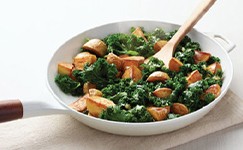Expert Tips and Tricks for Cooking and Baking with Plant-Based Butters
New to vegan or plant-based cooking and baking? Follow this advice from a top chef.
BY MEGHAN RABBITT
When Pete Ghione opened Truth & Tonic Wellness Café, the first and only 100 percent plant-based restaurant on the Las Vegas Strip, he knew he wouldn’t have to sacrifice flavor to make delicious food and baked goods that everyone would love.

The key, says Ghione, is focusing on a plant-based diet. And the best part is that it’s easier than ever to cook and bake with strictly plant-based ingredients—including butter.
“Foods and baked goods that call for traditional butter can turn out great when you use plant-based butter instead,” he says. “We make everything from shortbread cookies to biscotti to omelets with plant-based butter and get the same kind of taste and texture that you expect.”
To help you get started cooking and baking with plant-based butters, follow this advice:

When you’re following a conventional recipe and making tweaks so it’s 100 percent plant-based, odds are you’ll have to make some adjustments in how much of a different ingredient you use. Good news: That isn’t the case with plant-based butter, says Ghione. “You can use equal amounts plant-based butters as you would traditional butter,” he says.

Ghione likes to think of ingredients as if they’re friends and family you’ve invited over for a party. “Odds are you gravitate toward some more than others,” he says. “You can add your favorite flavors and ingredients to plant-based butter to amp up the flavor of whatever you’re making.” For example, you might mix in the zest of one lemon to a tablespoon of plant-based butter before you sauté kale or spinach. Or, mix in a tablespoon of maple syrup to a couple tablespoons of plant-based butter to make a sweet compote for spreading on toast or a scone.

While you might use high-heat when cooking with butter or vegetable oil, Ghione suggests turning the temperature down a touch when you’re sautéing foods with plant-based butters. It’ll help you get a great consistency without heating the ingredients in the plant-based butter (such as olive oil) above their smoke point.

While you can swap plant-based butter for dairy butter in any of your favorite baked-goods recipes, there are also a growing number of recipes that call for plant-based butter. These Berry Swirl Butter Cake and Apple Cranberry Crostata recipes are proof that you can make dairy-free sweets that are every bit as tasty as their conventional butter-laden counterparts.

Roasted vegetables are one of the easiest ways to boost your produce intake—something experts agree all of us could do to optimize our health. Rather than pour oil over those veggies, melt a serving of plant-based butter to drizzle on top. Try this simple Roasted Kale and Potatoes recipe to get started.






Share this Post